#Coin reveals little-known Roman ruler
Text
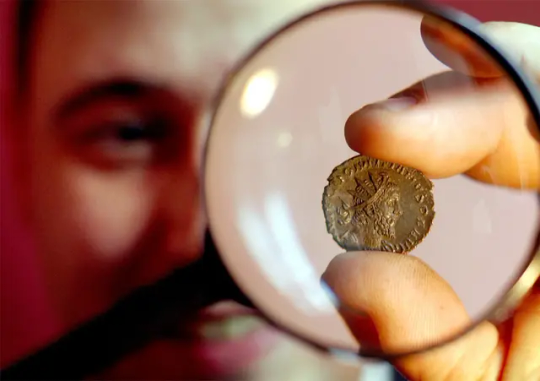
Coin reveals little-known Roman ruler
Treasure hunters have unearthed a coin bearing the head of a virtually unknown Roman ruler who briefly held power in Gaul around A.D. 270 as the empire teetered.
It is only the second coin ever found showing the head of Domitianus, who seized power — and the mint — in the breakaway Gallic Empire, which included modern England, France and parts of Germany and lasted for 15 turbulent years.
“We know next to nothing about Domitianus, except that he was ‘punished’ by the Roman Emperor Aurelian for treason,” Richard Abdy, curator of Roman coins at the British Museum, told Reuters. “But at least now we know what he looked like.”
Studied by coin experts
The first coin bearing Domitianus’ head was found in the Loire area of France in 1900, dismissed as a fake because his name was unknown and then lost from sight in a small museum in Nantes until very recently.
“It is now being studied by numismatists. When I showed our coin to the woman who has been working on it she jumped for joy because it bore out everything she had said about hers,” Abdy said, noting the French coin had been dated to A.D. 271.
The Gallic Empire was established in 260, when rule from Rome was weakening, by Postumus. He was succeeded nine years later by Marius, who held the throne for a matter of weeks before being strangled and in turn replaced by Victorinus, who ruled until 271 when he too was murdered.
Domitianus is believed to have murdered Victorinus, who had a habit of raping the wives of his subordinates, before himself being ousted by Tetricus. Tetricus ruled from 271 to 274, when he was defeated by Aurelian and the empire was restored.
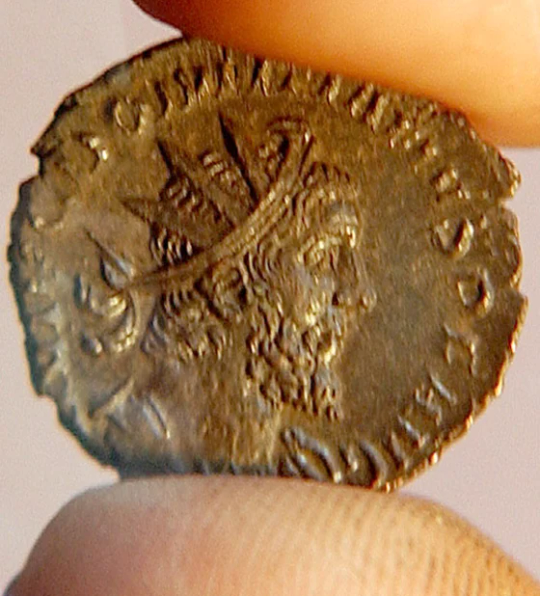
Found on farmland
The British coin, which goes on show at the British Museum starting Wednesday, was found on farmland near Oxford just under a year ago as part of a hoard of 5,000 Roman coins fused together in an earthenware pot.
“It is a type of coin we know as a ‘radiant’ because there are rays radiating from his head. It is a two-denarii piece, which at that time, when they were coining money as fast as they could, would have been worth a couple of hours’ work,” Abdy said.
The base metal coin, which originally had a surface coating of silver, is now conservatively estimated to be worth a five-figure sum, Abdy said.
At the time it was minted, the once-mighty Roman Empire was undergoing a period of intense flux.
The years between 270 and 285 were marked by chaos in the empire, with more than 20 different emperors and 30 different pretenders fighting for power. Only one of these leaders died a natural death.
By Jeremy Lovell.
Original posted Feb. 24, 2004.
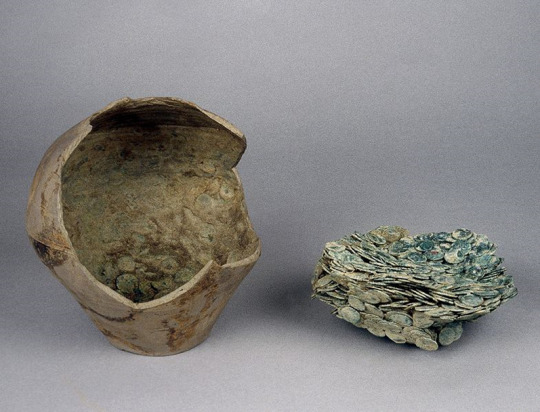

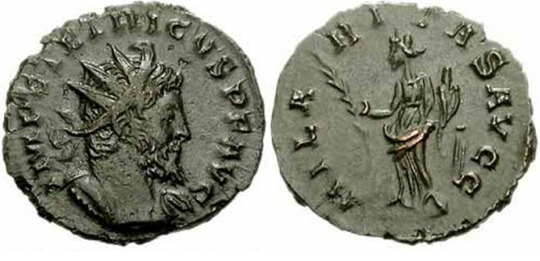
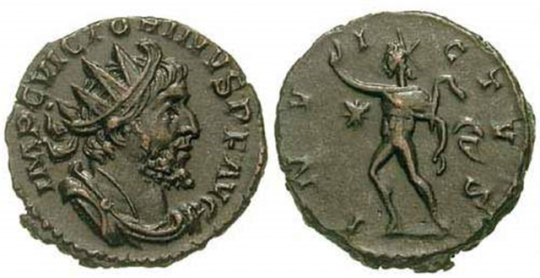
The Coin Hoard
Until this discovery was made some scholars doubted the historical significance of Domitianus who is named just twice in the historical sources. The Oxfordshire coin provides archaeological evidence suggesting that he successfully proclaimed himself emperor of a breakaway part of the Roman Empire during the reign of Aurelian (AD 270-5).
Richard Abdy (Curator of Roman coins at the British Museum) said that ‘during the 270s AD the fabric of the Roman Empire had become strained. Breakaway empires, like the so-called ‘Gallic Empire’ that included Britain, were established and ruled by a succession of rebel emperors. Finding a coin produced in the name of Domitianus means that he should now be recognised as one such rebel emperor.’
The failure of Roman writers to identify him as a rebel emperor even led the only other coin of Domitianus – found in France in 1900 – to be dismissed as a modern fake. The new discovery was struck from the same dies that were used to produce this earlier find and has therefore put its authenticity beyond any doubt.
Ian Leins (Finds Adviser, Iron Age and Roman coins, Portable Antiquities Scheme) said ‘the portrait on the new coin very closely resembles that of the rebel emperors Victorinus and Tetricus. It is highly possible that other coins of Domitianus exist in the collections of museums and individuals but have escaped detection. It is important that people start to pay more attention to these often neglected finds and record them with their local Finds Liaison Officer.’
#Coin reveals little-known Roman ruler#coins#collectable coins#roman coins#rebel emperor#Domitianus#Gaul#Gallic Empire#Aurelian#ancient artifacts#archeology#archeolgst#history#history news#ancient history#ancient culture#ancient civilizations#roman history#roman empire#roman emperor
61 notes
·
View notes
Text
A Story of Split
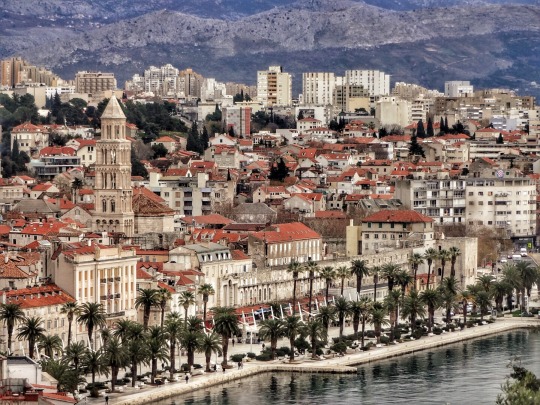
I recently visited Split, Croatia. It's steeped in history. Wherever you turn, you’re mired in it. When you lean back in your chair in one of the numerous cafes of the old town, your shirt is brushing against 1700-year-old Roman wall. You sip your coffee and can almost hear in your mind the banter of legionnaires who leaned against this same wall with cups of wine during the break from duty. Houses of the downtown Split sprout like unruly hair from within the Roman limestone walls dating from 3rd century A.D. The city’s Cathedral of St. Domnius is consecrated in 7th century. The black granite sphinx guarding the front entrance to the cathedral is estimated to be from 15th century B.C. It is no wonder then that an aspiring scribe who finds himself walking the cobblestone streets of ancient times can’t stop imagination from running wildly back through centuries. Allow me to take you through the time to the very beginning of Split:
The year is 260. We are standing at the seashore in Aspàlathos, a Greek trading outpost in a charming bay on the central coast of Dalmatia. Several ships are tied to the shore, their sails folded like the wings of seagulls lining their masts and the shore. Slaves and sailors bustle over gangplanks, unloading ships and loading the others. At our back, the habitat is not much to look at, just a few rows of stone houses stretching along the shore. Most of them have dual function, as a warehouse and an abode. People who own them are from the Greek colony of Issa on the island of Vis. It’s about half a day sail south-southwest from here. Aspàlathos was built for one purpose: trade. It's trading with Dalmatae and other Illyrian tribes inhabiting the coast and hinterland of the Balkans, and with Romans from Salona, a metropolis of 60,000 souls, the Roman capital of the province of Dalmatia, and a cultural, political and commercial center of the region. It sits less than two-hour walk, or half an hour on a fast horse from Aspàlathos.
Next to us stands a lanky youth. His shoulders are wide and long muscles are taught from military training. His hair is cropped short, revealing high brow and sharp features. He wears a legionnaire's uniform, with leather-strap sandals instead of boots, common for legionnaires on those warm days of spring. He gazes into the distance, dreaming of faraway places, dreaming of seeing Rome one day. He's only 16, eager to leave family's nest. Next to him stands a man with stooped shoulders holding his hands behind his back. Man's fingers are smeared with ink, an unmistakable mark of a scribe. His squints at the youth.
"Diocles, my son," the man speaks, "go with fortune and may Jupiter keep you safe and return you to us. When you can, send us a word, so that we know you're alive and well." The man places a hand on Diocles's shoulder and the youth turns to meet his eyes.
"Remember," the man continues, "when you tire of marching and battles, your home will wait for you. You won't find a better place to rest than this." The man swipes an arm wide over the peaceful bay, the village and rolling green hills behind it.
Diocles smiles at the man. "I know, father. Thank you. It's time to go back to my legion."
They clasp forearms for a long moment, eyes locked on each other's. Then Diocles breaks the hold and walks with long, impatient strides north, across the hills, toward Salona and its garrison. His father returns to the house which is also his office. A scribe is an important part of every trade, the hand that writes contracts, permits, receipts and counts coins. Unfortunately, most of those coins are transferred from one client to another, from a buyer to a seller. A pay for scribe's services will not build him a palace. Diocles's father is doing alright, keeping his family well fed and clothed, with solid roof over their head, and a nice little farm where his wife tends to her cabbages which grow so well in this weather. He hoped to pass all this to Diocles one day, but the youth is eager to see the world, as young men often are. And what better way to do it, but with the mightiest army of the time: Roman legions.
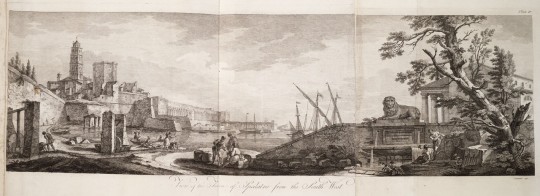
Thirty-five years later, in 295 A.D., the youth who is now a man of over 50, returns to the bay of his youth. He observes the works started to build a large structure that will stretch from the seashore and climb the gentle slope of the hill. His name has changed, as is his appearance; he is stockier now, almost stout. His chestnut hair, streaked with grey throughout, recedes further from his brow, and his jaw and face are covered by neatly trimmed salt-and-pepper beard and moustache. A toga picta died Tyrian purple was draped over his shoulders, marking his stature. He is Gaius Aurelius Valerius Diocletianus, or Diocletian, the emperor of the Roman Empire. The structure whose foundations are just being built is going to be known as Diocletian's Palace.

In the year 305 A.D. Imperator Caesar Gaius Aurelius Valerius Diocletianus - Diocletian for short - took his stroll along the raised promenade atop the southern wall of his new home. Flowerbeds and trees lined the promenade on both sides to offer the emperor shade from the scorching Adriatic sun. A few marble benches were placed in regular intervals to allow a breathtaking view over the Brettia channel at the islands Brettia (today's Brač) and Solentium (today's Šolta). The emperor moved with shuffling steps, leaning on a cane for support. He was gaunt, his cheeks were hollowed, his shoulders stooped and boney. His skin was grey and a size too large for a man he became. Diocletian was fighting an ailment for over a year, a mysterious illness that almost killed him. It left him emaciated and weak. Next to Diocletian walked a stout man with powerful if somewhat stooped shoulders and strong arms clasped leisurely behind his back. He had open round face with eyes perpetually half-closed and eyebrows that climbed a touch too high, giving him a disbelieving, inquisitive expression. The lower half of his face was obscured in bushy dark hair which greyed at the sides, trimmed to follow the line of a strong jaw. His meaty lips were slightly downturned as if in disapproval. He was Maximian Herculius, co-emperor and Diocletian's partner in ruling the empire that grew too big for a single person to rule over. When Diocletian was confirmed as the emperor of Rome, he turned east to secure the eastern borders of the empire. He soon realized that the news from the Gaul and western borders of the empire travelled too long and his imperial decisions and decrees weren't reaching the west in time. To remedy it, Diocletian elevated his friend Maximian to Cesar, and soon after Augustus, making him equal in status, an emperor in the west, although Diocletian's seniority gave him the upper hand in decision-making. The two worked well together, Maximian's military brawn complemented Diocletian's political wisdom and the alliance born of friendship lasted throughout the twenty years of their rein.
Reaching the bench, Diocletian gingerly lowered himself on it and lifted his face toward the healing warmth of Dalmatian sun. The almost forgotten scent of the homeland wafted to his nostrils.
"I think, my friend, that I can get easily used to retirement," he smiled. "I already feel better."
"You'll miss the action when your strength returns," Maximian grunted in response. "Is your wife joining you?"
Diocletian shook his head. "Prisca is staying in Thessalonica with Galerius and Valeria. She may come when my strength returns."
Galerius was Diocletian son-in-law and successor, the Cesar in the East. His wife - Diocletian's daughter Valeria asked her mother Prisca to stay with them.
"Come Maximian," Diocletian reached his hands to his friend who helped him stand up - "let me show you the gardens. I'm going to grow cabbage here, the way my family did." They walked on to the colonnaded gardens accessible from the promenade.
Diocletian's failing health made the other emperors of the tetrarchy convince him and Maximian to retire. Weakened by disease, Diocletian accepted without much objection. Maximian resisted at first, but Diocletian talked him into leaving the post to younger men. Not suffering idleness well, Maximian sailed to visit his friend's retirement home.
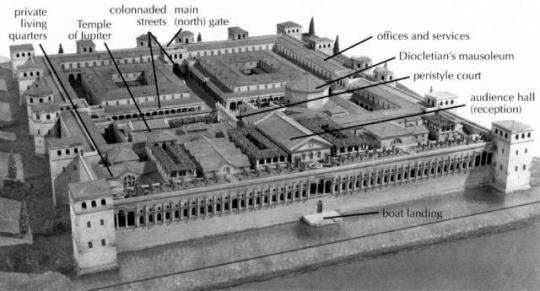
It was an imposing fortress built at the place Diocletian called home so many decades earlier. An impressive walled compound had 16 watchtowers along east, west and north land-facing walls. The only unfortified wall was the southern wall, built on the edge of the sea. Its only opening was a small landing for the imperial galley and supply ships. The walls were built of large limestone blocks. An arcaded gallery bearing the tree-lined promenade stretched along the south wall. The imperial palace with private living quarters and audience hall covered the south half of the fortress. A Peristyle with a balcony from which the emperor greeted his subjects was the very center of the compound. The west side of the Peristyle housed the temple of Jupiter with gardens built for worshipers. The emperor attended the round temple of Jupiter on the east side of the square. The main streets traversing the fortress from east to west and north, met at the forum on the north edge of the Peristyle. The north half of the compound held twin military garrisons for the emperor's legions.

Upon Diocletian's death in 312 A.D., the palace was reclaimed as a property of Roman Republic, and was used as a refuge for exiled dignitaries and deposed rulers. In 7th century A.D. the Roman metropolis of Salona was sacked and destroyed by invading Slavs. Refugees fled from the ruins of the city to find refuge within Spalato's fortified walls. Once luxurious palace and garrison compound was taken down. Its stones were used to build many smaller houses. With time, the willy-nilly building continued outside the Roman walls, under different rulers. Venetians built another set of walls to protect the city from the Croatian-Hungarian and later Ottoman threat. Parts of the wall, as well as "Mletačka kula" (The Venetian Tower) have grown into the tissue of modern days Split.
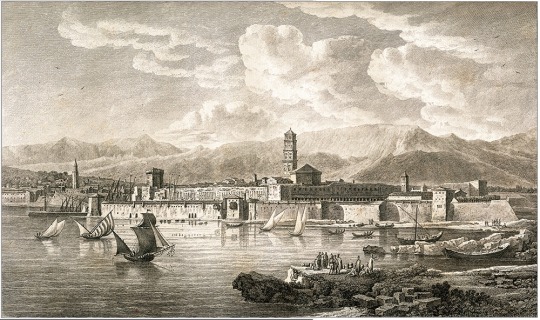

#writing#amwriting#history#historical fiction#travel#split#spalato#croatia#roman empire#diocletian#ancient
2 notes
·
View notes
Text
Past plagues offer lessons for society after the coronavirus pandemic
It was an optimistic time. A healthy economy showered wealth on elites and allowed many ordinary citizens to live comfortably. Local goods and exotic imports filled shops and markets. Political leaders ruled a vast network of cities and trade routes.
Then the enemy attacked. An infectious disease leapfrogged from one population center to another. People died in droves. Political leaders scrambled to recover from a dizzying sucker punch to public and economic health.
This is not a tale about the United States or any other nation besieged by the new coronavirus. Instead, it’s a story about the ancient Roman Empire, where a contagion known as the Antonine Plague felled victims throughout the realm, from Egypt to continental Europe and the British Isles in the late 160s.
Accurate mortality data for the Antonine Plague don’t exist. But written accounts from that time point to mass deaths. Physician and philosopher Galen described victims as suffering from open sores in the windpipe, rashes of dark blisters, vomiting, diarrhea, fever and other symptoms of what may have been smallpox. Perhaps 7 million to 8 million people perished in what some consider to be history’s first pandemic, says Kyle Harper of the University of Oklahoma in Norman. Harper is a historian of the Roman Empire and ancient epidemics.
The Antonine Plague and other epidemics and pandemics that struck before 20th century vaccines and medical knowledge hold lessons, but no easy answers, for governments and people today grappling with COVID-19.
One lesson looms large: Societies can’t indefinitely avoid outbreaks, but they can withstand even severe pandemics. Past political systems have found ways to bounce back from mass illness and unthinkable numbers of deaths.
The extent to which deadly outbreaks have altered the course of civilizations is controversial, though. Some scholars, such as Harper, contend that pandemics often changed political systems in big ways. Other investigators argue that pandemics, though deadly, caused relatively little political and economic havoc.
Whatever the political and economic fallout, pandemics and epidemics have typically had social consequences, for better or worse. For instance, devastating yellow fever outbreaks in the 19th century bolstered the institution of slavery in New Orleans, whereas in Haiti the disease actually helped slaves seeking freedom from French colonists.
“Sometimes [infectious diseases] accelerate history or reveal where a society was already going, while sometimes they fundamentally change the trajectory of societies,” Harper says.
Diseased empire
Sometimes pandemics do both in the same society. Widespread infectious disease influenced both the expansion and decline of the Roman Empire, Harper argues. In his 2017 book The Fate of Rome: Climate, Disease and the End of an Empire, he contends that pandemics interacted with climate fluctuations to induce resilience at first and later irreversible weaknesses in the Roman Empire.
Humans of course suffered from infectious diseases well before Roman times. In particular, the origin of cities, starting about 6,000 years ago, brought people into closer quarters, where bacteria and viruses could more easily spread, especially through contaminated food and water supplies in a time before proper sanitation.
But it wasn’t until the rise of Rome that the elements needed to bring about pandemics appear to have come together for the first time. Population growth and long-distance trade in the Roman Empire proved a boon to diseases that jumped from animals to people, such as smallpox and measles.
The Antonine Plague struck during the reign of Marcus Aurelius in the late 160s. Though millions died, the empire was big enough to absorb those losses, which still left roughly 90 percent of the empire’s population intact, Harper says. Political reorganization and power sharing were required to counteract food shortages and an economic decline in the wake of the pandemic. Marcus Aurelius invited civic leaders from throughout the empire to join his imperial government. Their wealth and knowledge helped Roman elites to improve conditions in the empire’s provinces, and provincial governments were given greater power to resolve local issues.
Roman society rebounded, at least for a while.
Possible first pandemic
This map show the extent of the Roman Empire (dark gray) at the time of Marcus Aurelius’ reign. Red dots mark sites where written sources possibly refer to the Antonine Plague, which began in 165 and may have been the first pandemic.
Roman Empire sites linked to the Antonine Plague

C. Chang
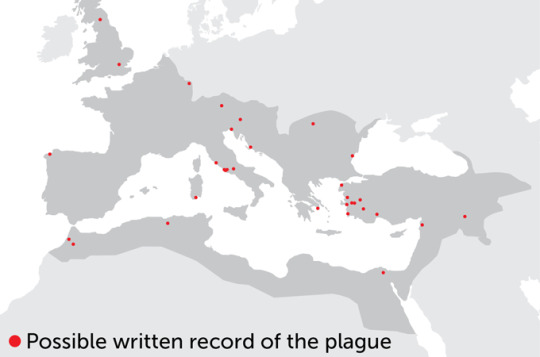
C. Chang
Source: K. Harper/The Fate of Rome 2017
Then, in the mid-200s, a poorly understood pestilence known as the Plague of Cyprian swept through the Roman Empire. Eyewitness accounts, including that of the disease’s namesake, Cyprian the Bishop of Carthage, described painful deaths preceded by days of fatigue, bloody stool, fever, bleeding from the eyes, blindness and hearing loss. An influenza virus or a viral hemorrhagic fever similar to yellow fever and Ebola may have caused this deadly outbreak, Harper suspects.
Combined with drought, foreign invasions, infighting among generals and a rapid loss of coin values, the Plague of Cyprian brought the Roman Empire to its knees. For over a decade, the disease spread and likely killed a larger percentage of the population than the Antonine Plague had, Harper says, though precise numbers are hard to establish. As the central government reeled, a series of emperors were chosen — and sometimes quickly deposed — by the military based on an aspiring ruler’s popularity with generals. But the empire never regained its former prominence, Harper says.
Sign up for e-mail updates on the latest coronavirus news and research
By the early 400s, the western half of the Roman Empire gave way to foreign invaders. In the east, the empire held on for a bit. But in the mid-500s, an outbreak of bubonic plague known as the Justinianic Plague, caused by the bacterium Yersinia pestis (SN: 12/6/18), spread through Roman territory just as volcanic eruptions caused substantially cooler global temperatures, likely leading to lower Mediterranean crop yields, Harper contends. Death rates likely reached 50 percent or more of the population, he suspects. Soon after, the Roman Empire suffered military losses to Islamic armies and was reduced to a minor state.
Rather than swiftly destroying the Roman realm, plague and climate change “sapped the vitality of the empire,” Harper says.
Political resilience
Harper’s reconstruction of Roman history rings hollow to environmental historian Merle Eisenberg. Even given large mortality rates, the plagues that hit the Roman Empire had limited social and political fallout, Eisenberg, of the University of Maryland’s National Socio-Environmental Synthesis Center in Annapolis, contends.
Written and archaeological data recently analyzed by Eisenberg and colleagues (SN: 12/2/19) indicate that life during the Justinianic Plague, for instance, proceeded much as it had before the outbreak in some places. Roman legislation continued to be issued, the monetary system remained stable and farmland continued to be cultivated, as indicated by ancient pollen collected from lake beds. “Plague certainly struck the Mediterranean, but it did not seem to impact the lives of most people,” Eisenberg says.
If a majority of Roman subjects had died, there should have been less time to bury plague victims with inscribed tombstones and less money to erect new buildings with inscriptions detailing who built them and why. But the number of such inscriptions in Syria, a region hit hard by the plague, stayed stable during the pandemic, Eisenberg’s group reported in December in the Proceedings of the National Academy of Sciences. Eisenberg concludes that substantially less than half of the Roman Empire’s population must have succumbed to the Justinianic Plague.

Yersinia pestis bacteria (yellow in this scanning electron micrograph of the spines, purple, lining a flea’s digestive system) caused a series of plagues in Europe, including the Justinianic Plague in the Roman Empire [ok]and the medieval Black Death.National Institute of Allergy and Infectious Diseases/NIH
That estimate is based on limited evidence that doesn’t tap into the Justinianic Plague’s broad political and social effects across the Roman Empire, Harper argues. But given considerable gaps in what’s known about how that outbreak played out from one region to another, this debate will be difficult to resolve.
For his part, Eisenberg says true devastation from a pandemic didn’t arrive until the medieval Black Death, which killed perhaps 75 million to 200 million people — half of Europe’s population — from 1346 to 1351. Recurrences of the Black Death, caused by the same bacterium as the Justinianic Plague, lasted until the 18th century in Europe and the 19th century in the Middle East. But even the Black Death fell far short of causing civilization to collapse, Eisenberg says.
Harper and other historians have suggested that the Black Death spared so few farmers and other laborers that survivors successfully demanded better working conditions from the ruling class. John Haldon, a Princeton University historian of ancient Europe and the Mediterranean, agrees that mass deaths spurred economic shifts, such as a gradual loosening of the feudal system in which peasants received parcels of land in return for serving a lord or king. “Yet there were no political collapses at all,” says Haldon, who supervised Eisenberg’s graduate research but did not participate in his Justinianic Plague study. Western European states and kingdoms stayed largely intact during medieval times.
In modern times, better medical care and vaccines have generally kept pandemic mortality rates below those suffered centuries ago. But a modern, globalized world in which many nations are economically intertwined and communications flash instantly across continents is especially vulnerable to financial disruptions when pandemics strike, Eisenberg suspects.
“Premodern plagues generally caused more deaths than infectious diseases today do,” he says. “But pandemics today, such as COVID-19, have larger political and economic impacts than those in the past.”
From his perspective, history’s lesson for people now is to stay vigilant: Once the coronavirus has been medically contained, the hard work of dealing with the pandemic’s shocks to our way of life must accelerate.
Certifiably immune
Those shocks sometimes run deep. Unrelenting outbreaks of infectious disease can modify an existing social order or even help to bring it down, historians have found.
Consider yellow fever. The mosquito-borne viral disease aided a successful rebellion of black slaves in Haiti against French colonial rule. Yale University historian of science and medicine Frank Snowden describes that event in his 2019 book Epidemics and Society: From the Black Death to the Present.
Haiti’s slave uprising lasted from 1791 to 1804. When Napoleon sent more than 60,000 soldiers to put down the rebellion, many European newcomers quickly succumbed to yellow fever because they lacked immunity that black Haitians had already acquired. Yellow fever ended up helping Haiti’s slaves win their freedom.

Previous exposure to yellow fever helped surviving Haitians launch a successful slave rebellion against French soldiers who lacked immunity to the infection. An 1802 battle in that struggle is illustrated here.Auguste Raffet/Wikimedia Commons
The disease also thwarted Napoleon’s ambitions to expand his empire into the Americas, Snowden says. In 1803, as a humiliating military defeat fast approached in Haiti and prospects of war with Britain increased, the cash-strapped French ruler sold Louisiana to the United States. That transaction, which expanded slavery’s reach in the U.S. South, set the stage for yellow fever to instigate entirely different social changes in 19th century New Orleans.
Yellow fever killed more than 150,000 people there between 1803 and the Civil War’s start in 1860. No cure or vaccination existed for a disease that killed about half of those it infected. Yellow fever deaths were painful and horrifying. Many victims vomited thick, black blood before succumbing after several days. Those who survived the infection became immune, or what people at the time called “acclimated.”
In a city with stark divisions between rich and poor, men and women and within racial groups — whites, “free people of color” and slaves — acclimated citizens held special status, says Stanford University historian Kathryn Olivarius. That immunity-based social system produced New Orleans’ most powerful and wealthy families, many of which are still prominent, Olivarius concluded in the April 2019 American Historical Review. Her analysis included written accounts, official documents and medical articles from the pre–Civil War era.
White people who survived yellow fever could receive a certificate of acclimation, ensuring them access to good jobs, bank loans and houses in the best neighborhoods. Many immigrants arriving in New Orleans in the 1840s, especially Irish and Germans, saw infection as a path to success and were willing to risk death to become acclimated.
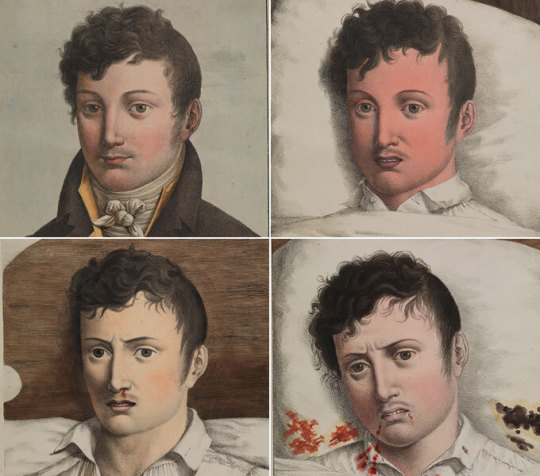
Getting yellow fever, depicted in this 1819 painting, could result in bleeding and vomiting of thick, black blood. Because yellow fever was often fatal, some survivors of the disease achieved special status in New Orleans during the 19th century.Wellcome Collection (CC BY 4.0)
Black people received no such benefits. Not only did the slave economy withstand repeated epidemics, but resistance to yellow fever and the likelihood of a long working life increased a slave’s monetary value to an owner by 25 to 50 percent, Olivarius estimates.
It’s not yet clear if someone who recovers from COVID-19 gains immunity (SN: 4/28/20), as with yellow fever. Even so, possibly immune individuals are drawing attention in this year of the coronavirus. Countries such as Chile, Germany and the United Kingdom are considering issuing “immunity passports” — documents certifying that a person has recovered from COVID-19 — that would let these individuals go back to work early. Immunity passports might become an increasingly attractive strategy as it takes a year or more to develop a coronavirus vaccine. “If so, we should heed lessons from the past and beware of potential social perils,” Olivarius says.
Forgetting pandemics
A final lesson to glean from the past is perhaps the hardest to follow: Don’t forget what happened. Don’t let the next generation forget, either, because another outbreak will surely arrive when it is least expected.
Snowden observes that the influenza pandemic of 1918 and 1919, which killed an estimated 50 million people or more worldwide, was put out of mind by many people soon after it burned out. “It’s curious how such a major event could be so quickly forgotten,” Snowden said on April 2 during an online interview hosted by JAMA.
Scientists have warned for the last 20 years — as a series of infectious diseases including SARS, MERS and Zika emerged — that new pandemics and epidemics are on the horizon, Snowden said in the JAMA interview. Yet the United States and other countries were woefully unprepared for COVID-19.
See all our coverage of the coronavirus outbreak
Perhaps pandemic forgetfulness is as contagious as infectious diseases. In his 1722 book A Journal of the Plague Year, Daniel Defoe, also the author of Robinson Crusoe, used historical accounts to construct a fictional man’s experiences during an actual 1665 bubonic plague outbreak in London.
Defoe presents harrowing accounts of plague deaths and forced isolation of the infected in their homes. Yet as infections waned, people flocked into the streets and “cast off all apprehensions” when they encountered individuals limping from plague-caused groin sores and exhibiting other symptoms that “were frightful to the last degree, but the week before.”
In any age, a return to the soothing certainty of daily routines can help erase memories of having dodged a viral killer. Time will tell if this “viral amnesia” repeats itself when COVID-19 finally retreats.
.image-mobile { display: none; } @media (max-width: 400px) { .image-mobile { display: block; } .image-desktop { display: none; } }
from Tips By Frank https://www.sciencenews.org/article/coronavirus-covid-19-ancient-plagues-pandemics-lessons-society
0 notes
Photo



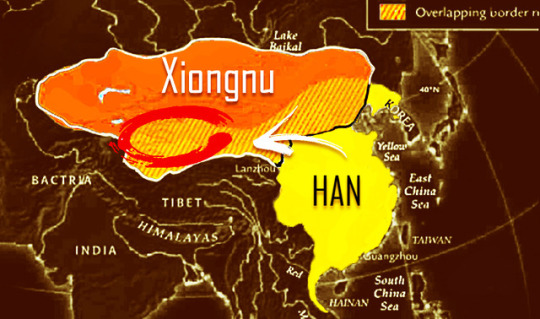





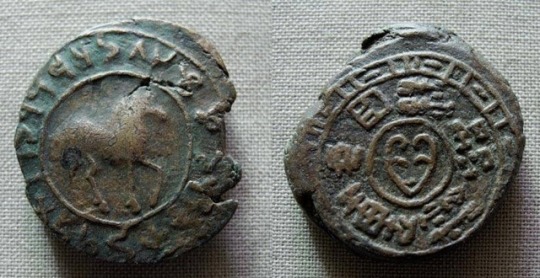
Qin Dynasty
“The Qin Dynasty established the first empire in China, starting with efforts in 230 B.C....The empire existed only briefly from 221 to 206 B.C., but the Qin Dynasty had a lasting cultural impact on the dynasties that followed.
As the ruler of Qin, Ying Zheng took the name Qin Shi Huang Di (“first emperor of Qin”), which brings together the words for “Mythical Ruler” and “God.”...Citizens were discouraged from using the emperor’s personal name in documents...One of the most important outcomes of the Qin conquest was the standardization of non-alphabetic written script across all of China, replacing the previous regional scripts.”
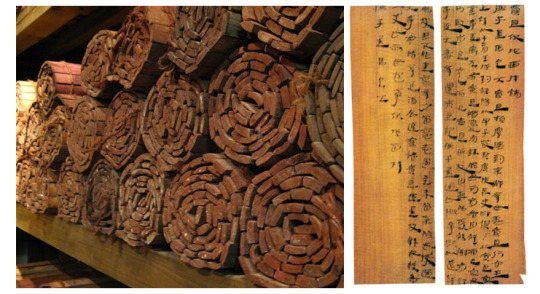
“The new script enabled parts of the empire that did not speak the same language to communicate together, and led to the founding of an imperial academy to oversee all texts. As part of the university effort, older philosophical texts were confiscated and restricted (though not destroyed, as accounts during the Han Dynasty would later claim).”

“The Qin also standardized weights and measures...impose them on merchants to simplify trade and commerce across the empire. In conjunction with this, bronze coins were created to standardize money across the regions.
The Qin empire is known for...a complex system of over 4,000 miles of road and one superhighway, the Straight Road, which ran for about 500 miles...and is the pathway on which materials for the Great Wall were transported. The empire’s borders were marked on the north by border walls that were connected, and these were expanded into the beginnings of the Great Wall.”

”Qin Shi Huang developed an army of life-size statues—almost 8,000 terra cotta warriors and 600 terra cotta horses, plus chariots, stables and...weapons and other treasures...is now famous as the Terra Cotta Army. Excavation...has been delayed due to high levels of toxic mercury at the site—it’s believed that the emperor had liquid mercury installed in the tomb to mimic rivers and lakes.”

“Qin Shi Huang died in 210 B.C. while touring eastern China. Officials traveling with him wanted to keep it secret...They also forged a letter from Qin Shi Huang, sent to crown prince Fu Su, ordering him to [die]...allowing the officials to establish Qin Shi Huang’s younger son as the new emperor...In two years time, most of the empire had revolted against the new emperor...Warlord Xiang Yu...defeated the Qin army in battle, executed the emperor, destroyed the capital and split up the empire into 18 states.
Liu Bang, who was given the Han River Valley to rule, quickly rose up against other local kings and then waged a three-year revolt against Xiang Yu. In 202 B.C., Xiang Yu [was assasinated], and Liu Bang assumed the title of emperor of the Han Dynasty, adopting many of the Qin dynasty institutions and traditions.”
(via Qin Dynasty - HISTORY)

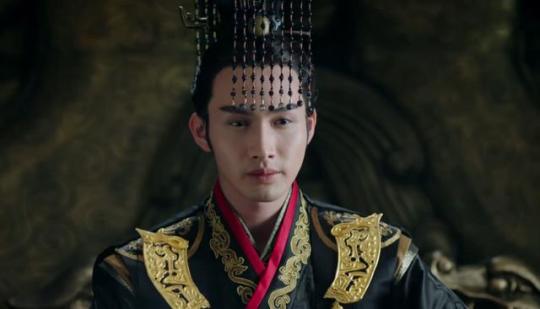
Qin Er Shi
“The First Emperor Qin Shi Huang died during one of his tours of Eastern China, on September 10, 210 BCE (Julian Calendar) at the palace in Shaqiu prefecture. The announcement of his death was withheld until the entourage, which was accompanied by Premier Li Si and the imperial court, returned to the capital Xianyang two months later. Nevertheless, Huhai and Zhao Gao were aware of Qin Shi Huang's death and began plotting an internal intrigue.
The eldest son Fusu was supposed to be elected as the next emperor. However, Premier Li Si and the Chief Eunuch Zhao Gao conspired to kill Fusu...Li Si and Zhao Gao forged a fake edict by Qin Shi Huang...the younger son Huhai acceded the throne to become the Second Emperor later known as Qin Er Shi.”

“[On] 207 BC, eunuch Zhao Gao tested his power against the emperor's. He presented a deer to the Second Emperor, but called it a horse. The emperor laughed and said "Is the chancellor perhaps mistaken, calling a deer a horse?" Then the emperor questioned those around him. Some remained silent, some aligned with Zhao Gao, and said it was a horse. Zhao Gao executed every official who called the deer a deer.
Qin Er Shi reigned only for three years and was forced to commit suicide eventually by his most trusted minister Zhao Gao at the age of 24. Qin Er Shi was condemned by the Eunuch Chancellor Zhao Gao after his death and was denied a royal burial.”

Could these be the faces of the murdered wife and son of China’s first emperor Qin Shi Huang?
“Chinese researchers have reconstructed the faces of a young man and woman who could be one of the many sons and consorts of Qin Shi Huang, the first emperor of China – and who may also have been victims of one of the most notorious and gruesome purges in Chinese history.
[I]n the emperor’s mausoleum in Xian – home to the famed terracotta army. Researchers have reconstructed the face of one of the high-status women in the tombs – possibly a wife or concubine of the emperor...she had a pair of rounded, large eyes and long, defined nose...although details such as her hair style and eye colour can only be guessed at...Intriguingly, her features do not appear to be typically Han Chinese. Instead they suggest a possible central Asian or even European ancestry.
They had been buried with a large number of valuable artefacts, including ceramics, jade accessories, silks, bronze swords, silverware and gold bars...The possible Qin prince, according to the facial reconstruction, appeared to be a man about 30 years of age with olive-shaped eyes and a pronounced nose...The faces, especially the woman’s, appeared to show more ethnic divergence than would typically be expected in Han Chinese people. Some researchers have speculated that the women might have “Western” origins – possibly Persian, or even European.”

”Qin Shi Huang commanded one of the most powerful military forces in the ancient world and conquered all the rival kingdoms to form the first unified Chinese state...they were armed with some of the most advanced weapons of the time, including crossbows that could hit targets up to 800 metres away.”

“[A]ccording to Sima Qian, a historian living in Han dynasty about a hundred years later. After the emperor’s death in 210BC his younger son Hu Hai seized the throne by covering up his father’s death and forging his will to force his older brother to commit suicide. According to Sima a “large number” of these women were sacrificed and buried in the mausoleum...although no evidence to support this has been found.
Then Hu Hai moved on to persecute his siblings, as he feared they would challenge his legitimacy.Eighteen princes were publicly executed and their bodies put on display while four princes were forced to take their own lives. Nor did Hu spare his sisters. According to Sima’s account, 10 princesses met gruesome deaths.”
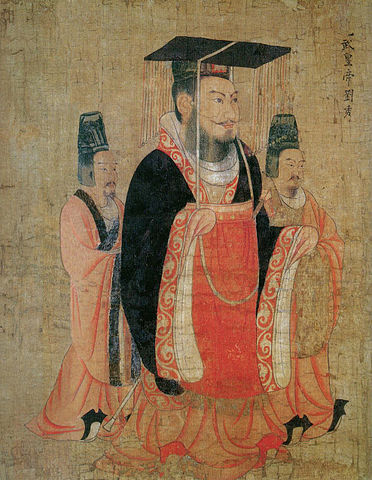
“Zhang Zhongli, a senior archaeologist at Shaanxi Archaeological Institute in Xian, said Sima Qian’s accounts were “quite reliable”. As a government historian, Sima had direct access to official archives from the Qin empire...Zhang conceded it was possible that some travellers from the West had reached the Qin empire and that the imperial court had a degree of ethnic diversity.
Following the conquests of Persia and parts of India by Alexander the Great a century earlier, his Greek successors had established a European presence in central Asia. But Zhang argued it was unlikely that there were extensive or regular contacts between China and the West at the time...The arrival of visitors from the West or the Near East would have been a rare event.”
(via Could these be the faces of the murdered wife and son of China’s first emperor Qin Shi Huang? | South China Morning Post)
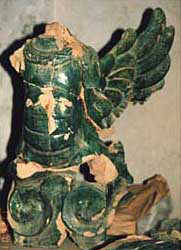
History upended! China's Terracotta Army perhaps built by Greeks
“Startling new discoveries by Chinese archaeologists suggest that the famous Terracotta Army may have been built or designed by Ancient Greek sculptors who traveled to the country...Every so often, a new discovery comes along which questions what we believed to be an irrefutable truth about the past...Until now, the impression given to us by historians is that Ancient China was something of a hermit kingdom, hidden behind its Great Wall and with little or no contact with the outside world, until along came Marco Polo in the 13th century.”

”Before this, the trade conducted through the Silk Road seemed to have been no more than the exchange of goods...However, it now seems likely that, not only was there extensive trade of goods between China and the West, but substantial cultural exchange, as well, even to the extent of Europeans living in China as guests.”

”In modern times, historians have shown that China had a highly-developed civilization on a par with Ancient Egypt, Greece and Rome, which co-existed during the same period in history. However, it has always been presumed that the great Western civilizations of antiquity and the Chinese Imperial dynasties developed in isolation from one another.”

“That now appears to be incorrect and just as the civilizations of Mesopotamia, Egypt, Greece and Rome influenced one another, China could also have borrowed cultural styles and expertise from the Greeks. The recent discovery of coins from the Roman Empire in Japan also suggests that our concept of East-West relations in ancient times was erroneous.”

“It is thought that Greek statues of the period, which arrived in Asia following the conquests of Alexander the Great, caught the attention of Chinese royal artists and statesmen and, consequently, Greek craftsmen were invited to China to advise and participate in the building of the famous army.
“We now have evidence that close contact existed between the first emperor’s China and the west... We now think the Terracotta Army, the acrobats, and the bronze sculptures found on site, have been inspired by ancient Greek sculptures and art.”
(via History upended! China's Terracotta Army perhaps built by Greeks | Digital Journal)

Secrets of Chinese Terra-Cotta Warrior Weapons Revealed
“Now, scientists have figured out how the bronze triggers for the crossbows of the 8,000 terra-cotta warriors were manufactured. Teams of craftspeople worked in small groups to produce the bronze pieces in batches for the tomb of ancient Emperor Qin Shi Huang, according to a new study detailed in the March issue of the journal Antiquity...craftspeople sculpted about 8,000 colorful warriors - likely using real human beings as inspiration - and those warriors wore stone armor and "wielded" lances, swords and crossbows.”

”But it wasn't clear exactly how these ancient weapons were made. The crossbows were made of wood or bamboo that rotted long ago, and only the tips and triggers for the bows remained...The lack of wear on the metal pieces suggests the weapons were never used in actual battle, but were instead built solely for the tomb...The pieces were mostly uniform, suggesting the interlocking trigger parts were made in the same or nearly-identical molds and produced in small batches."
(via Secrets of Chinese Terra-Cotta Warrior Weapons Revealed | Live Science)


TERRACOTTA WARRIORS: DEFENDERS OF CHINA’S FIRST EMPEROR
“[T]hey were first arranged in battle formation, each one of the almost 8,000 warriors was colorfully painted, and his clothing, armor, face, hair, headdress, and hands were realistically portrayed. however, with the demise of the empire, the Han rebels burnt down the pits, destroying the sculptures and changing their colors forever. cinnabar, malachite, and azurite, as well as bone white and Han purple (a rare pigment produced from barium copper silicate), were commonly mixed with lacquer, a natural resin from the lacquer tree...large quantities of pigments were ground into sufficient powder...for the red pigment alone, about two tons of cinnabar powder would have been prepared! the original kneeling archer is one of only six still bearing, traces of the pigments.”

“[T]he Han dynasty condemned its Qin predecessor, yet retained most of the First Emperor’s policies. in Han times, the general view of the First Emperor was that he had governed harshly, capriciously, and onerously. after his death, the people rebelled out of despair...the first Han ruler, Emperor Gaozu...continued the policies of the First Emperor, including a single law code for all subjects, an appointed bureaucracy, an imperial academy, uniform standards in writing and other fields, and an army based on the peasantry. above all, he upheld the idea of the Emperor: a quasi-divine person who embodied the state, personified the unity of a diverse land and acted as the supreme governor judge, and priest of the realm.”

(via TERRACOTTA WARRIORS: DEFENDERS OF CHINA’S FIRST EMPEROR | Lost, Found and Remembered blog)

Eight Kings of the Relic Story, fresco in the Maya cave in Kizil, Tarim Basin, China

Dacians
“The Dacians were known as Geta (plural Getae) in Ancient Greek writings, and as Dacus (plural Daci) or Getae in Roman documents...It was Herodotus who first used the ethnonym Getae in his Histories. In Greek and Latin, in the writings of Julius Caesar, Strabo, and Pliny the Elder, the people became known as 'the Dacians'. Getae and Dacians were interchangeable terms, or used with some confusion by the Greeks.”

“There is no doubt that the Thracian language was related to the Dacian language which was spoken in what is today Romania, before some of that area was occupied by the Romans. Also, both Thracian and Dacian have one of the main satem characteristic changes of Indo-European language, *k and *g to *s and *z. With regard to the term "Getic" (Getae), even though attempts have been made to distinguish between Dacian and Getic, there seems no compelling reason to disregard the view of the Greek geographer Strabo that the Daci and the Getae, Thracian tribes dwelling north of the Danube (the Daci in the west of the area and the Getae further east), were one and the same people and spoke the same language.”
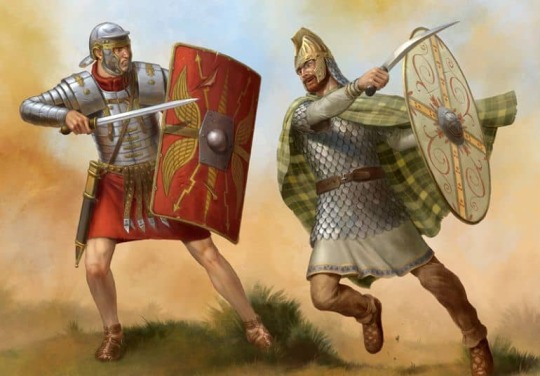
“After the Dacian Wars (AD 101-6), the Romans occupied only about half of the wider Dacian region. The Roman province of Dacia covered just western Wallachia as far as the Limes Transalutanus (East of the river Aluta, or Olt) and Transylvania.”

Roman-Dacian mercenary soldier
Daqin
“Daqin is the ancient Chinese name for the Roman Empire or, depending on context, the Near East, especially Syria. It literally means the "great China", Qin (Chinese: 秦; pinyin: Qín; Wade–Giles: Ch'in) being the name of the founding dynasty of the Chinese Empire. Historian John Foster defined it as "the Roman Empire, or rather that part of it which alone was known to the Chinese, Syria.
The term Daqin (Chinese: 大秦; pinyin: Dà qín; Wade–Giles: Ta-ch'in), meaning "Great Qin," is derived from the dynasty founded by Qin Shihuangdi, ruler of the State of Qin and China's first emperor who unified China's Warring States by 221 BC. The prefix "da" (大) or "great" signified that the Roman Empire was on par with the might of the Qin Empire and was viewed as a utopian land located to the northwest of the Parthian Empire.”
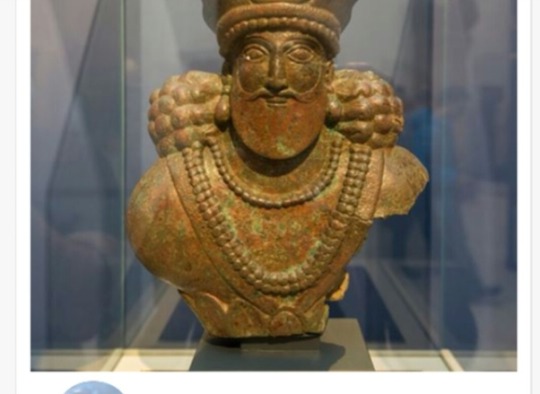
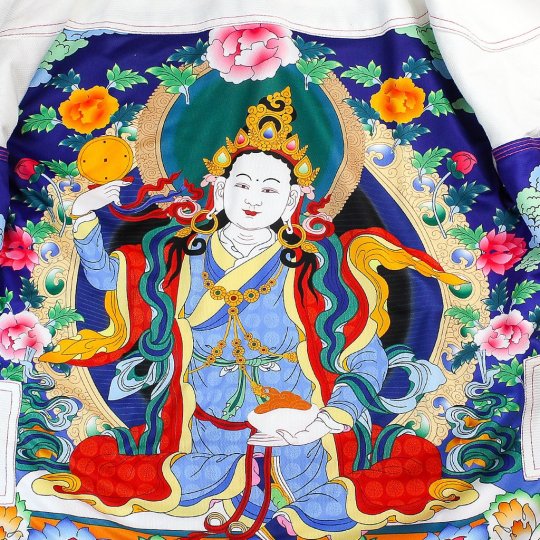
Hanfu movement
“The Hanfu movement is a social movement that has developed in China since the beginning of the 21st century. In 2003, supporters of Han revivalism launched the website Hanwang, "Han Network" to promote "traditional" Han clothing and Han supremacist agenda. Participants revitalize their utopian vision of the authentic “Great Han” and corresponding “real China” through dress, reinvented Confucian ritual and anti-foreign sentiment. They seek to restore and stress the purity and superiority of "traditional Chinese culture" through the promotion of the wearing of the "hanfu" which they claim to be the "traditional ethnic clothing" of the majority Han Chinese ethnic group.”

“You can’t have nationalism without race. That’s what we want to do: promote Han racial nationalism...The multiracial nationalism we have now in China, with 56 races as part of a larger “Chinese race” is a big scam. It was imposed upon us by the Manchus, forcing us Han, the core of China from the beginning of time, into submission. All that this nationalism has done is to weaken China. You can’t just destroy the distinction between civilization and barbarism, incorporate a bunch of barbarians into our nation and then expect a strong nation. All this talk of “wealth and power” is empty and meaningless without Han nationalism.“

“The word "Hanfu" is not included in the authoritative dictionary of Standard Mandarin Chinese "Contemporary Chinese Dictionary" and its modern definition was created by internet users around the year 2003...According to "Dictionary of Old Chinese Clothing", the term "hanfu" means "dress of the Han people." It is a concept to distinguish Han people's dress from minority clothing. The term/concept of "hanfu" which is not commonly used in ancient times...there is no clear history indicating that there was any such apparel in existence under the name "hanfu".

“The advocates of the movement believe the term "hanfu" refers to the vanished, pre-17th century historical clothing worn by the Han people, and the meaning of Hanfu in the movement is the same from what it was in the historical records, yet scholarly research indicates that the "modern definition of Hanfu" was created on Chinese-language, collaborative, web-based encyclopedia Baidu Baike and Chinese online platform“hanwang” by internet users.”

Kimono
“The kimono (着物) is a traditional Japanese garment. The term means "garment"; ki (着) means "to wear", and mono (物) means "thing" or "object". It has come to mean full-length formal robes...Kimonos are often worn for important festivals and formal occasions as formal clothing.”


Kinchaku
“A traditional Japanese drawstring bag or pouch, worn like a purse or handbag, for carrying around personal possessions.“

Geta
“Geta (下駄) are a form of traditional Japanese footwear that resemble clogs and flip-flops. They are a kind of sandal with an elevated wooden base held onto the foot with a fabric thong to keep the foot well above the ground.”

Qípáo
“The cheongsam is a typical, traditional, and feminine body-hugging dress with distinctive Chinese features of Manchu origin. It was also known as qípáo and was the Republic of China's mandarin gown.”

”When the Manchus ruled China during the Qing dynasty, they used an administrative division called the Eight Banner system. Originally only the Manchu households were organised within this system, but over time Mongols and Han Chinese were incorporated. The Manchus, and anyone living under the Eight Banners system, wore different clothing from ordinary civilians. Thus they became known as Banner People (Qí Rén, Qilin, Kirin). The Manchu clothing that they wore consisted of similar long robes for both men and women. These were called changpao.”

“After the feudal Qing dynasty was overturned, Chinese feminists called for women's liberation from traditional roles and they led several movements against the Neo-Confucian gender segregation, including a termination of bound feet for women, cutting off long hair which was conventionally symbolized as women's oriental beauty, and encouraging women to wear men's one-piece clothing, Changshan or "changpao"."Changpao" was traditionally taken as men's patent throughout the long history since Han Dynasty (202 BC to 220) to Qing Dynasty (1616–1911). During that time, Chinese Han female's clothing gradually developed into two pieces. Women were forbidden to wear robes as men did and instead had to wear tops and bottoms known as "Liang jie yi".”

Áo giao lĩnh
“The Áo giao lĩnh (Giao lãnh y,"cross-collared robe") was a traditional cross-collared robe worn by Vietnamese before the 19th century. During the Nguyen dynasty, it was replaced by the áo dài and became obsolete.”

Chiton
“A chiton was a form of clothing.There are two forms of chiton, the Doric chiton and the later Ionic chiton...The Doric chiton is a single rectangle of woolen or linen fabric. It can be worn plain or with an overfold called an apoptygma, which is more common to women...The Ionic chiton could also be made from linen or wool and was draped without the fold and held in place from neck to wrist by several small pins. A large belt called a zoster could be worn over the chiton.
A sleeved form was worn by priests and actors. The colour or pattern would often indicate status, but varied over time. The chiton was the outfit of Aphrodite because it was considered very feminine, although men also wore it. Dionysus is often depicted wearing it. The chiton was also worn by the Romans after the 3rd century BCE. However, they referred to it as a tunica.”

Khilat
“A khalat/[khilat] is a loose, long-sleeved outer silk or cotton robe common in Central Asia, Pakistan and northern India and worn both by men and women, although in differing styles. Historically, richly adorned khalats have been used as honorific awards, similarly to mantle. The word khalat/khilat was also used to denote the ceremony of awarding the honorific robe. Such social aspects of clothing have been known in many societies. By the 19th century in British India the word khillat had come to mean any gift of money or goods awarded by the Government of India in return for service from tributary princes, khans and tribal leaders.”

Greek key
“A meander or meandros is a decorative border constructed from a continuous line, shaped into a repeated motif. Such a design is also called the Greek fret or Greek key design, although these are modern designations.
Meanders are common decorative elements in Greek and Roman art. In ancient Greece they appear in many architectural friezes, and in bands on the pottery of ancient Greece...They were among the most important symbols in ancient Greece; and perhaps symbolized infinity and unity; many ancient Greek temples incorporated the sign of the meander.”

“Meanders are also prevalent on the pavement mosaics found in Roman villas throughout the Roman empire. A good example is at the Chedworth Roman Villa in England, leading many historians to believe that the pattern was part of the original inspiration for the Latin "G" character.”
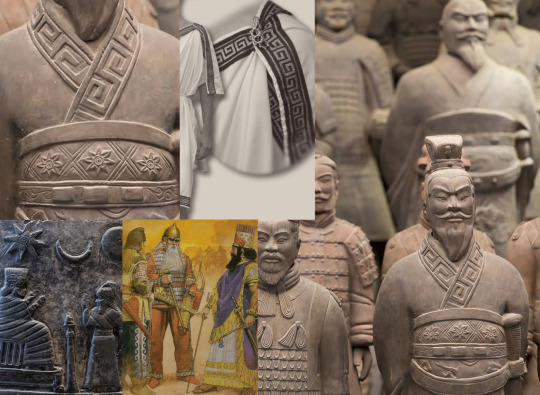
Star of Ishtar
“The Star of Ishtar or Star of Inanna is a symbol of the ancient Sumerian goddess Inanna and her East Semitic counterpart Ishtar. Alongside the lion, it was one of Ishtar's primary symbols. Because Ishtar was associated with the planet Venus, the star is also known as the Star of Venus.
The star of Inanna usually had eight points...It was Inanna's most common symbol and, in later times, it became the most common symbol of the goddess Ishtar...During later times, slaves who worked in Ishtar's temples were sometimes branded with the seal of the eight-pointed star. On boundary stones and cylinder seals, the eight-pointed star is sometimes shown alongside the crescent moon, which was the symbol of Sin, god of the Moon, and the rayed solar disk, which was a symbol of Shamash, the god of the Sun.”

The Forbidden History of Ancient China: Aryan Mummies and Hundreds of Pyramids
“The discoveries in the 1980s of the undisturbed 4,000-year-old "Beauty of Loulan" and the younger 3,000-year-old body of the "Charchan Man" are legendary in world archaeological circles for the fine state of their preservation and for the wealth of knowledge they bring to modern research...The ancient corpses, which avoided natural decomposition due to the dry atmosphere and alkaline soils in the Tarim Basin, have not only given scientists a look into their physical biologies, but their clothes, tools and burial rituals have given historians a glimpse into life in the Bronze Age.”

“[R]esearch has shown that in the second millennium BC, the oldest mummies, like the Loulan Beauty, were the earliest settlers in the Tarim Basin. From the evidence available, we have found that during the first 1,000 years after the Loulan Beauty, the only settlers in the Tarim Basin were Caucasoid."

”East Asian peoples only began showing up in the eastern portions of the Tarim Basin about 3,000 years ago, Mair said, while the Uighur peoples arrived after the collapse of the Orkon Uighur Kingdom, largely based in modern day Mongolia, around the year 842. Modern DNA and ancient DNA show that Uighurs, Kazaks, Krygyzs, the peoples of Central Asia are all mixed Caucasian and East Asian. The modern and ancient DNA tell the same story." China has only allowed the genetic studies in the last few years, with a 2004 study carried out by Jilin University also finding that the mummies' DNA had Europoid genes, further proving that the earliest settlers of Western China were not East Asians.”
(via The Forbidden History of Ancient China: Aryan Mummies and Hundreds of Pyramids | Humans Are Free blog)

Mysterious Ancient Chinese Mummy Buried with Greek Goddesses
“[A] rare find: a 1500-year-old tomb full of artifacts, complete with an intact mummy...The tomb also contained a puzzling find: a gilded silver bowl decorated with busts of gods and goddesses of the Greek Pantheon...However, the manufacturing techniques and design of the metalwork show some elements belonging to the peoples living in the Eurasian steppes. There are even some rare relics, such as the gilt silver bowl with Hellenistic motifs, which seem to be imports from Central and Western Asia.”

“The bowl inlaid with the Greek goddesses, in particular, has archaeologists fascinated and has been described as the most striking artifact found in the tomb. The fact that a dynastic ruler in a remote region of what today is Inner Mongolia had access to Greek trade goods shows a much higher degree of cultural diversity and sophistication than what has been typically assumed. This find, coupled with last year’s discovery of two individuals of Chinese ancestry in an ancient Roman cemetery, shows that the Middle Kingdom’s long and complex relationship with the rest of the world just might be more complex than we think.”
(via Mysterious Ancient Chinese Mummy Buried with Greek Goddesses | Earth Mystery News)

Pyramids in China

“U.S. Air Force Pilot James Gaussman was returning to Assam, in India...he later wrote:
"I flew around a mountain and then we came to a valley. Directly below us was a gigantic white pyramid. It looked as if it were from a fairy tale. The pyramid was draped in shimmering white. It could have been metal, or some other form of stone. It was white on all sides. What was most curious about it was its capstone: a large piece of precious gem-like material. I was deeply moved by the colossal size of the thing."
When Gaussman arrived back in Assam, combat duties pushed the sighting from his mind. Photographs he had taken of the giant pyramid would not be published for another 45 years. Till then, even his report would be buried in the Secret Service files of the U.S. military.”

“On March 28, 1947 the "New York Times" reported about that discovery. In an interview with the newspaper, the former far east director of the Transworld Airlines, Maurice Sheahan, says he has seen 40 miles southwest of Xian a gigantic pyramid."I was impressed by its perfect pyramidal form and its great size," says Sheahan. Later, on March 30, 1947 the "New York Sunday Times"...published the first photo, which is actually made in 1945 by Gaussman, and that was soon forgotten.”

“There are indeed pyramids in China! Google Earth confirmed that again. The biggest...pyramids are in the province Shaanxi, north of the city Sian (Xi´an). On the satellite photographs of Google Earth, no "white pyramid" is to be recognized...two pyramids are visible, but however they are not identical to the photo from 1947.”
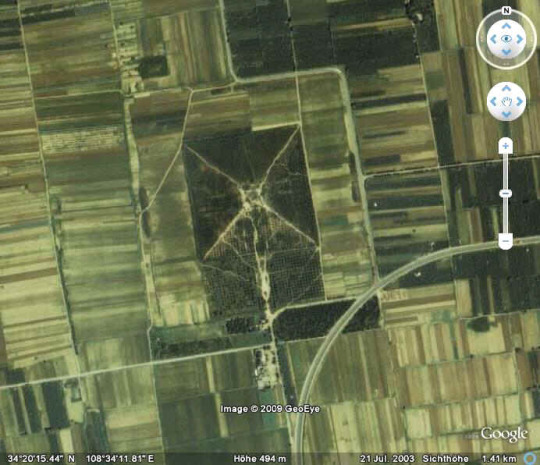
“This pyramid, of February 2009 by Google Earth, shows again the wellknown Maoling Mausoleum but in a better solution from GeoEye. The comparison above shows that is indeed the "white pyramid".

(via Pyramids in China | Ancient Mistery blog)


Liquid mercury found under Mexican pyramid could lead to king's tomb
“An archaeologist has discovered liquid mercury at the end of a tunnel beneath a Mexican pyramid... had discovered “large quantities” of liquid mercury in a chamber below the Pyramid of the Feathered Serpent, the third largest pyramid of Teotihuacan, the ruined city in central Mexico.”
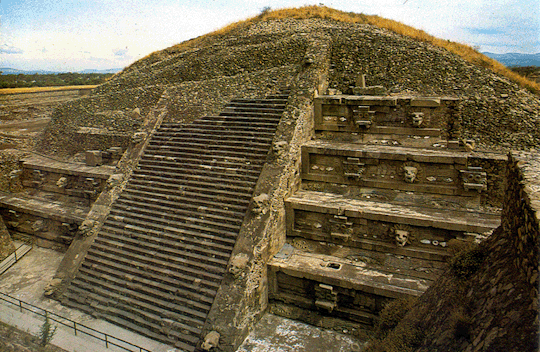
“Mercury is toxic...archaeologists have found mercury at three other sites around Central America...mercury was not the only object of fascination: “a lot of ritual objects were made reflective with mica,” a sparkling mineral likely imported to the region.”

“Water was also precious to many of the people of Mesoamerica, who knew of underground water systems and lakes that could be accessed through caves. Teotihuacan once had springs as well, though they are now dried out...the ancient Mesoamericans could produce liquid mercury by heating mercury ore, known as cinnabar, which they also used for its blood-red pigment. The Maya used cinnabar to decorate jade objects and color the bodies of their royalty, for instance; the people of Teotihuacan – for whom archaeologists have not agreed on a name – have not left any obvious royal remains for study.”

(via Liquid mercury found under Mexican pyramid could lead to king's tomb | The Guardian)


Cinnabar
“Cinnabar is a toxic mercury sulfide mineral with a chemical composition of HgS. It is the only important ore of mercury. It has a bright red color that has caused people to use it as a pigment and carve it into jewelry and ornaments for thousands of years in many parts of the world. Because it is toxic, its pigment and jewelry uses have almost been discontinued.
Cinnabar was mined at the volcano, ground into a very fine powder and then mixed with liquids to produce many types of paint. The bright red pigments known as "vermilion" and "Chinese red" were originally made from cinnabar.”
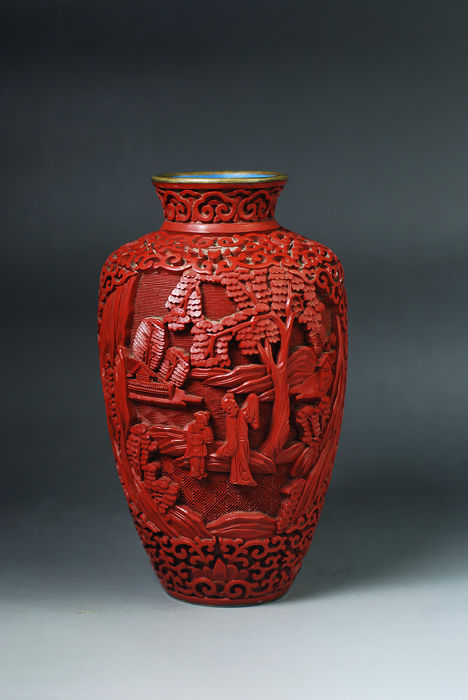
“Cinnabar has been especially popular for making red lacquer in China. Its use in lacquer has declined because of its toxicity, but some use of cinnabar in lacquer continues. Cinnabar has also been used in powdered form for ritual blessings and burials. Powdered cinnabar was used as a cosmetic in many parts of the world for thousands of years. Eventually it was discovered that cinnabar is toxic, and its use in pigments, paints, and cosmetics began to decline.”
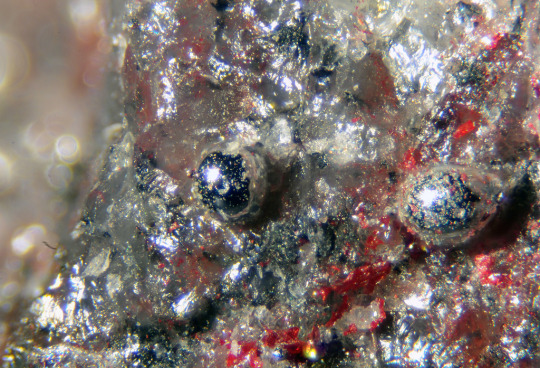
“Because cinnabar is the only important ore of mercury, the demand for mercury has driven mining activity. Mercury has many uses...Because it is toxic, it was once widely used to protect seed corn from fungus and to deworm materials used to make felt...Mercury has been widely used in mining to separate gold and silver from ores and stream sediments.”
(via Cinnabar | Geology.com)
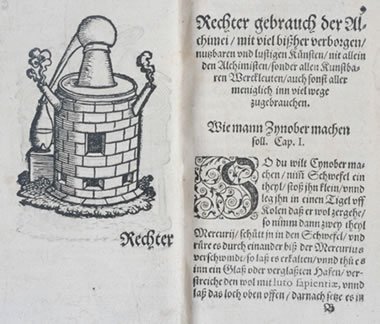
European mercury kiln capturing mercury vapors from heated cinnabar
youtube
Amalgam (chemistry)
“An amalgam is an alloy of mercury with another metal, which may be a liquid, a soft paste or a solid, depending upon the proportion of mercury. These alloys are formed through metallic bonding, with the electrostatic attractive force of the conduction electrons working to bind all the positively charged metal ions together into a crystal lattice structure. Almost all metals can form amalgams with mercury, the notable exceptions being iron, platinum, tungsten, and tantalum. Silver-mercury amalgams are important in dentistry, and gold-mercury amalgam is used in the extraction of gold from ore.”

”Mercury has been used in gold and silver mining because of the convenience and the ease with which mercury and the precious metals will amalgamate. In gold placer mining, in which minute specks of gold are washed from sand or gravel deposits, mercury was often used to separate the gold from other heavy minerals. After all of the practical metal had been taken out from the ore, the mercury was dispensed down a long copper trough, which formed a thin coating of mercury on the exterior. The waste ore was then transferred down the trough, and gold in the waste amalgamated with the mercury. This coating would then be scraped off and refined by evaporation to get rid of the mercury, leaving behind somewhat high-purity gold.”

“Mercury amalgamation was first used on silver ores with the development of the patio process in Mexico in 1557. Where stamp mills were used to crush gold-bearing ore to fines, a part of the extraction process involved the use of mercury-wetted copper plates, over which the crushed fines were washed. A periodic scraping and re-mercurizing of the plate resulted in amalgam for further processing. Amalgam obtained by either process was then heated in a distillation retort, recovering the mercury for reuse and leaving behind the gold”
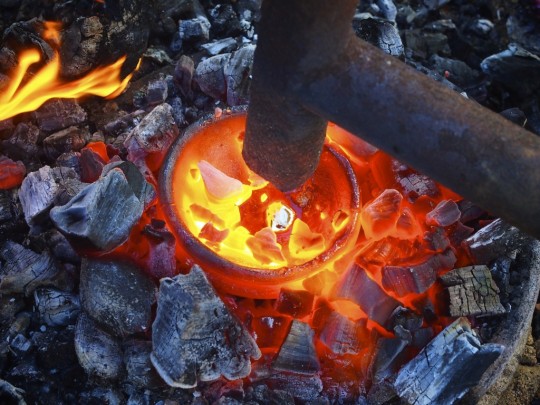
Mercury
“Mercury is one of the basic chemical elements. It is a heavy, silvery metal that is liquid at normal temperatures. Mercury readily forms alloys with other metals, and this makes it useful in processing gold and silver...Mercury has been found in Egyptian tombs dating to about 1500 B.C. , and it was probably used for cosmetic and medicinal purposes even earlier. In about 350 B.C. , the Greek philosopher and scientist Aristotle described how cinnabar ore was heated to extract mercury for religious ceremonies. The Romans used mercury for a variety of purposes and gave it the name hydrargyrum, meaning liquid silver, from which the chemical symbol for mercury, Hg, is derived. Demand for mercury greatly increased in 1557 with the development of a process that used mercury to extract silver from its ore.”
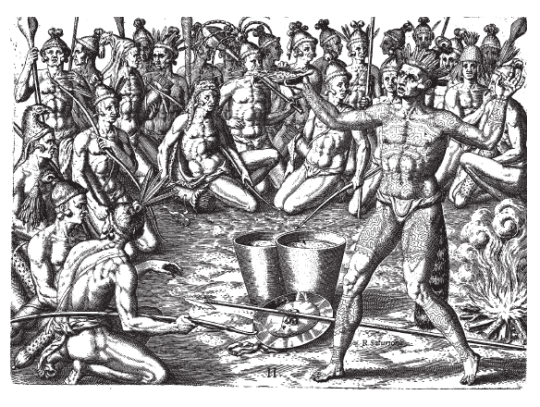
(via Mercury | How Products Are Made)
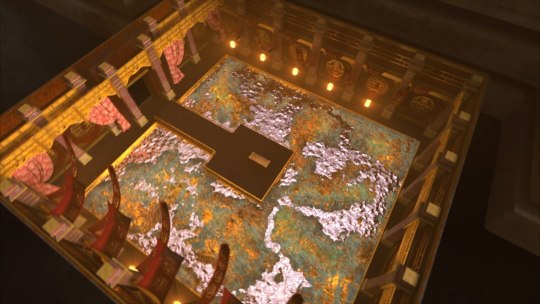
Flowing rivers of mercury
“[T]he Han dynasty historian Sima Qian, writing in second century BC...Most enticing of all is a detail relayed by Qian: ‘Mercury was used to fashion the hundred rivers, the Yellow river and the Yangtze river, and the seas in such a way that they flowed’.
By finally defeating the last of the rival states in 221BC, Zheng became Qin Shi Huangdi (meaning the First Qin Emperor), ruler of all China. Some etymologies trace the name China itself to the First Emperor dynasty (pronounced ‘chin’), and so you might imagine that it would have a very special status in Chinese history. But the unified state barely outlasted the death of the First Emperor himself – four years later it succumbed to a rebellion that became the much more durable Han dynasty (206BC–AD220).”

“The mound itself was originally about 0.5km by 0.5km (erosion has shrunk it a little) and the burial chamber lies about 30–40m below the original ground surface. Its shape has been mapped out by measuring gravity anomalies in the ground – an indication of hollow or less dense structures – and by looking for changes in the electrical resistivity of the soil, which result from buried structures or cavities. In this way, Chinese archaeologists have figured out the basic layout of the tomb over the past several decades. The chamber is about 80m east to west by 50m north to south, surrounded by a wall of closely packed earth and – to judge from other ancient Chinese tombs – perhaps water-proofed with stone covered with red lacquer. In 2000 researchers discovered that towards the edge of the mound an underground dam and drainage system helps to keep water away from the chamber.”

”The first detailed study of mercury levels in the mound were conducted in the early 1980s...If you squint at this distribution, you can persuade yourself that it matches the locations of the two great rivers of China – the Yellow and Yangtze – as seen from the ancient Qin capital of Xianyang, close to modern Xi’an. ‘The distribution of mercury level corresponds to the location of waterways in the Qin empire’...however, isn’t so sure that one can conclude much from the present day mercury distribution...’The mercury will have volatilised into nearby soils during this long time, so it would be impossible to show up detailed information that we can connect with particular rivers or lakes.’”

”In any case, just because the mausoleum apparently contains a lot of mercury doesn’t in itself verify Qian’s account. Mercury had other uses too, particularly in alchemy, which has some of its oldest roots in China. In the west this art was commonly associated with attempts to make gold from other metals, and some Chinese alchemists tried that too – in 144BC the Han emperor Jingdi decreed that anyone caught trying to make counterfeit gold should be executed.
And perhaps mercury (in Chinese ‘shui yin’, literally ‘water silver’) was the key to these. Chinese legend tells of one Huang An, who prolonged his life for at least 10,000 years by eating mercury sulfide (the mineral cinnabar)...mercury was a common ingredient of medicines being used to treat infected sores, scabies, ringworm and (even more alarmingly) as a sedative for mania and insomnia. Because it is bright red, cinnabar was also used for art and decoration in China since around the second millennium BC. Its artificial form, produced in the west since the Roman era, became known as the pigment vermilion.”
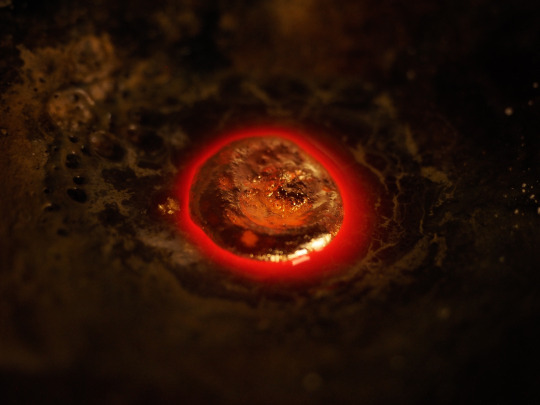
“One of the most important uses of mercury at this time has a particularly alchemical tinge. Gold and silver dissolve in mercury to form amalgams, and such mixtures were used for gilt plating. The amalgam was rubbed on and heated to evaporate the mercury leaving behind a gleaming coat of precious metal.
Throughout antiquity cinnabar was the source of all mercury metal. There was a lot of this mineral in China, particularly in the west. Shaanxi alone contains almost a fifth of all the cinnabar reserves in the country, and there are very ancient mines in Xunyang county in the south of the province that are a good candidate source of the mercury apparently in the First Emperor’s tomb.“

“To extract mercury from cinnabar one need only roast it in air, converting the sulfur to sulfur dioxide while the mercury is released as vapour that can then be condensed. Since mercury boils at 357°C, this process needs temperatures well within the capabilities of Qin-era kilns...closed chambers weren’t used until the Han period.
But despite there being a mature mercury-refining technology by the time of the First Emperor... So even though mercury, either as cinnabar or as the elemental metal, has been found in tombs dating back as far as the second millennium BC, it’s not clear why it was put there...Yet even if this mercury was indeed used for fantastical landscaping...the chamber might have contained at most 100 tons of the liquid metal: around 7m3.”

(via Flowing rivers of mercury | The Royal Society of Chemistry)
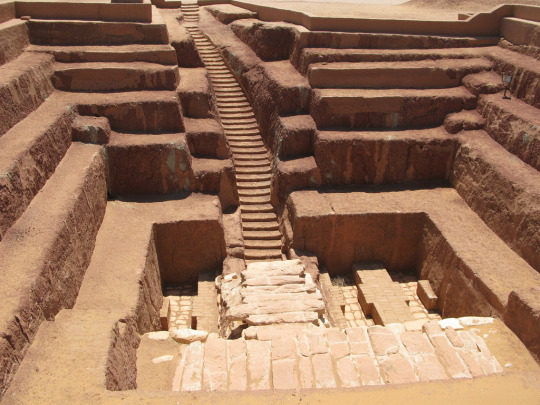
Qila al-Dabba Mastaba, Dakla Oasis, Giza, Egypt

The myth of red mercury
““Red mercury”, one of the things the robbers may have been looking for, is a mythic substance for many Egyptians. They believe that in the throats of mummies there is a liquid called red mercury. If someone possesses this liquid, he or she will be able to control the spirits and become rich. Of course, there is no such thing as red mercury, but many people still believe in it all over Egypt.”
(via The myth of red mercury | Al-Ahram Weekly)

Giza Plateau Mastaba
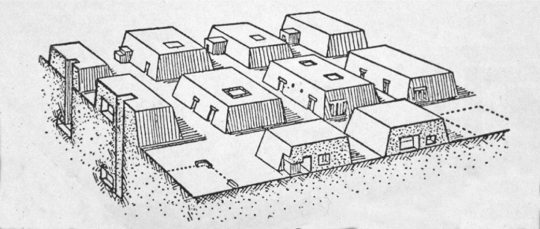

Gold
“The oldest known map of a gold mine was drawn in the 19th Dynasty of Ancient Egypt (1320–1200 BC), whereas the first written reference to gold was recorded in the 12th Dynasty around 1900 BC...Egypt and especially Nubia had the resources to make them major gold-producing areas for much of history.”

“In Roman metallurgy, new methods for extracting gold on a large scale were developed by introducing hydraulic mining methods, especially in Hispania from 25 BC onwards and in Dacia from 106 AD onwards. One of their largest mines was at Las Medulas in León, where seven long aqueducts enabled them to sluice most of a large alluvial deposit. The mines at Roşia Montană in Transylvania were also very large, and until very recently, still mined by opencast methods.”

“The European exploration of the Americas was fueled in no small part by reports of the gold ornaments displayed in great profusion by Native American peoples, especially in Mesoamerica, Peru, Ecuador and Colombia. The Aztecs regarded gold as the product of the gods, calling it literally "god excrement" (teocuitlatl in Nahuatl), and after Moctezuma II was killed, most of this gold was shipped to Spain.”


Gold in Ancient China
“[A]ncient literary references to gold as a material are not clear cut. The Chinese character for gold, 金 jin was generally used to mean ‘metal’ without specifically referring to gold. Texts telling of either its mining or use are not only scarce but also general.”
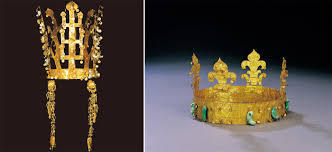
“Initial descriptions of gold transactions recounted amounts of a few dozen to a hundred jin at a time being handed over, but it has since been confirmed that after the Qin dynasty there was never transactions of that amount at one time. The amount of gold would therefore seem to have mysteriously vanished...Certainly since then, there has not been anywhere near an abundance of gold in China ”
(via Gold in Ancient China | China Dispatch)
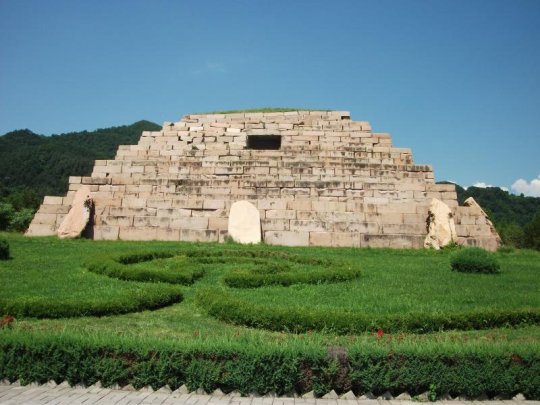
Ancient Korea
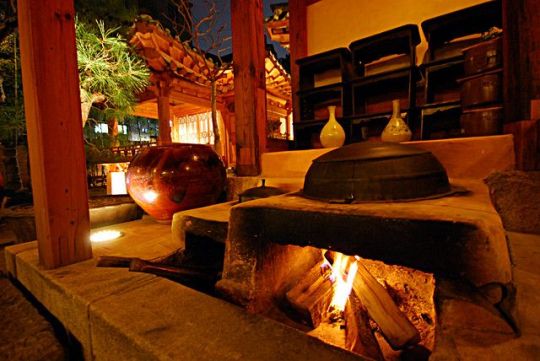
“Ancient Korea has provided many unique contributions to world culture including the invention of movable metal type printing, superb celadon ceramics, the exquisite gold crowns of Silla, the oldest astronomical observatory in Asia, fine gilt-bronze Buddhist figurines, stone pagodas, hanji, the most prized paper in the world, and the ondol underfloor heating system.”


“The Korean Bronze Age covered the same period with the metal culture brought from Manchuria. The presence of fine bronze goods such as swords, bells, and mirrors in certain tombs along the Taedon River indicates a culture with a tribal elite. Other common bronze items include slender daggers, spearheads, belt buckles, and fan-shaped axes. The Korean Iron Age began in the 3rd century BCE...It was in this period that the first state was formed, Gojoseon.”

“Gojoseon prospered due to agricultural improvements (with iron tools introduced from China) and plentiful natural resources like gold, silver, copper, tin, and zinc. At this time the famous ondol underfloor heating system was invented and the first Korean grey stoneware produced...Gojoseon finally collapsed in the 2nd century BCE, and its successor, Wiman Joseon, did not last very long either for in 108 BCE it was conquered by the Han dynasty of China (206 BCE – 220 CE). The Han were interested in natural resources such as salt and iron.”
(via Ancient Korea | Ancient History Encyclopedia)


Kiln
“The word kiln descends from the Old English cylene (/ˈkylene/, which was adapted from the Latin culīna "kitchen, cooking-stove, burning-place". During the Middle English Period, the "n" was not pronounced, as evidenced by kiln having frequently been spelled without the "n", Another word, "miln", a place where wheat is ground, also had a silent "n". Whereas the spelling of "miln" was changed to "mill" to match its pronunciation, "kiln" maintained its spelling, which most likely led to a common mispronunciation, which has now become commonly used.”

“A continuous kiln, sometimes called a tunnel kiln, is a long structure in which only the central portion is directly heated...Kiln technology is very old. The development of the kiln from a simple earthen trench filled with pots and fuel, pit firing, to modern methods happened in stages. One improvement was to build a firing chamber around pots with baffles and a stoking hole. This conserved heat. A chimney stack improves the air flow or draw of the kiln, thus burning the fuel more completely.”

”Chinese kiln technology has always been a key factor in the development of Chinese pottery, and until recent centuries was far ahead of other parts of the world. The Chinese developed effective kilns capable of firing at around 1,000 °C before 2000 BC. These were updraft kilns, often built below ground. Two main types of kiln were developed by about 200 AD and remained in use until modern times. These are the dragon kiln of hilly southern China, usually fuelled by wood, long and thin and running up a slope, and the horseshoe-shaped mantou kiln of the north Chinese plains, smaller and more compact. Both could reliably produce the temperatures of up to 1300 °C or more needed for porcelain. In the late Ming, the egg-shaped kiln or zhenyao was developed at Jingdezhen, but mainly used there. This was something of a compromise between the other types, and offered locations in the firing chamber with a range of firing conditions.”

“Both Ancient Roman pottery and medieval Chinese pottery could be fired in industrial quantities, with tens of thousands of pieces in a single firing. Early examples of simpler kilns found in Britain include those that made roof-tiles during the Roman occupation. These kilns were built up the side of a slope, such that a fire could be lit at the bottom and the heat would rise up into the kiln.”
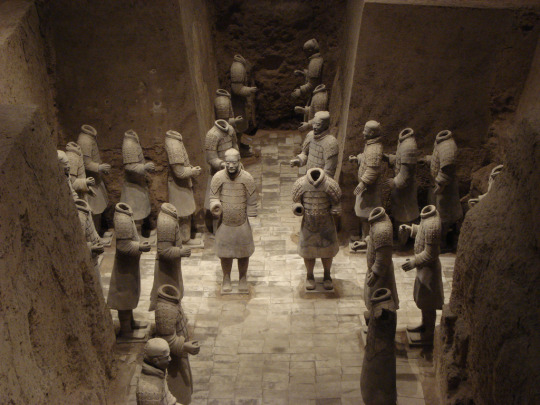
Terracotta
“Terracotta, terra cotta or terra-cotta (Italian: "baked earth", from the Latin terra cocta), a type of earthenware, is a clay-based unglazedor glazed ceramic, where the fired body is porous...An appropriate refined clay is formed to the desired shape. After drying it is placed in a kiln or atop combustible material in a pit, and then fired. The typical firing temperature is around 1,000 °C (1,830 °F), though it may be as low as 600 °C (1,112 °F) in historic and archaeological examples. The iron content, reacting with oxygen during firing, gives the fired body a reddish color, though the overall color varies widely across shades of yellow, orange, buff, red, "terracotta".”
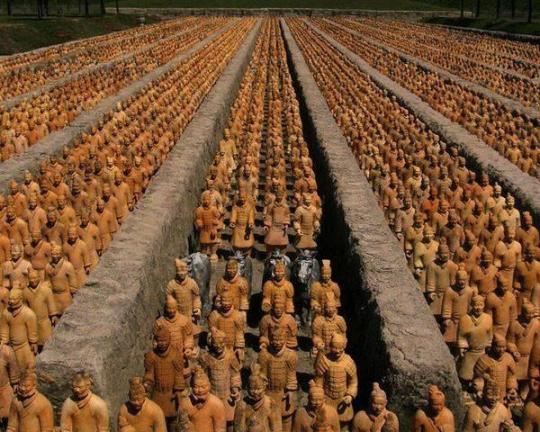
Mingqi
“Mingqi sometimes referred to as "spirit objects" or "vessels for ghosts", are Chinese burial goods...Mingqi also could include figurines, spiritual representations rather than real people...Mingqi served to provide the deceased with necessities and comforts in the afterlife...Joss offerings, also referred to as mingqi.”

Censorate
“The Censorate was a high-level supervisory agency in ancient China, first established during the Qin dynasty (221–207 BCE). The Censorate was a highly effective agency during the Mongol Yuan dynasty (1271-1368).
During the Ming dynasty (1368–1644), the Censorate was a branch of the centralized bureaucracy, paralleling the Six Ministries and the five Chief Military Commissions, and was directly responsible to the emperor. The investigating censors were "the eyes and ears" of the emperor and checked administrators at each level to prevent corruption and malfeasance, a common feature of that period. Popular stories told of righteous censors revealing corruption as well as censors who accepted bribes.

Sinicization
“Sinicization, sinicisation, sinofication, or sinification is a process whereby non-Chinese societies come under the influence of Chinese culture, particularly Han Chinese culture, language, societal norms, and ethnic identity. Areas of influence include diet, writing, industry, education, language, law, lifestyle, politics, philosophy, religion, science and technology, culture, and value systems.”

“More broadly, "Sinicization" may refer to policies of acculturation, assimilation, or cultural imperialism imposed by China onto neighboring East Asian countries, and minority ethnic groups inside China. Evidence of this can be seen in the value systems, cuisine, architectural style, and lexicons. This is reflected in the histories of Japan, Korea and Vietnam for example, in the adoption of the Chinese writing system as the script of the Han Chinese has long been a unifying feature in the Sinosphere as the vehicle for exporting Chinese culture to these Asian countries.”

“The integration or assimilation policy is a type of nationalism aimed at strengthening of the Chinese identity among the population. Proponents believe integration will help to develop shared values, pride in being the country’s citizen, respect and acceptance towards cultural differences among citizens of China.”

“Critics argue that integration destroys ethnic diversity, language diversity, and cultural diversity. Analogous to North America with approximately 300 Native American languages and distinct ethnic groups; in China there are 292 non-Mandarin languages spoken by native peoples of the region. There are also a number of immigrant languages.”

Burning of books and burying of scholars
“The burning of books and burying of scholars (simplified Chinese: 焚书坑儒; traditional Chinese: 焚書坑儒; pinyin: fénshū kēngrú) refers to the supposed burning of texts in 213 BCE and live burial of 460 Confucian scholars in 212 BCE by the First Emperor of the Qin dynasty of Imperial China. The event caused the loss of many philosophical treatises of the Hundred Schools of Thought. The official philosophy of government ("legalism") survived.
Modern scholars doubt the details of the story in the Records of the Grand Historian—the main source—since Sima Qian, the author, wrote a century or so after the events and was an official of the Han dynasty, which could be expected to portray the previous rulers unfavorably. While it is clear that the First Emperor gathered and destroyed many works which he regarded as subversive, two copies of each school were to be preserved in imperial libraries. These were destroyed in the fighting following the fall of the dynasty.”
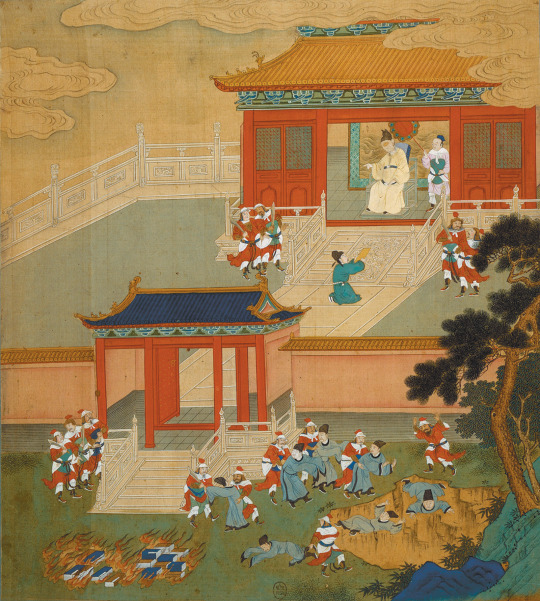
”According to the Sima Qian's Records of the Grand Historian (Shiji), after Qin Shi Huangdi, the first emperor of China, unified China in 221 BCE, his chancellor Li Si suggested suppressing intellectual discourse to unify thought and political opinion... Three categories of books were viewed by Li Si to be most dangerous politically. These were poetry (particularly the Shi Jing), history (Shujing and especially historical records of other states than Qin), and philosophy. The ancient collection of poetry and historical records contained many stories concerning the ancient virtuous rulers. Li Si believed that if the people were to read these works they were likely to invoke the past and become dissatisfied with the present. The reason for opposing various schools of philosophy was that they advocated political ideas often incompatible with the totalitarian regime.”

“The extent of the damage to Chinese intellectual heritage is difficult to assess, for details have not been recorded in history. Several facts, however, indicate that the consequences of this event, although enduring, had not been extensive. First, it is recorded in Li Si's memorial that all technological books were to be spared. Secondly, even the "objectionable" books, poetry and philosophy in particular, were preserved in imperial archives and allowed to be kept by the official scholars.”

“At the end of the Qin, the Epang Palace's national records were destroyed by fire. Tang dynasty poet Zhang Jie (Chinese: 章碣) wrote a poem (titled 焚书坑, Fen Shu Keng, "Pits for Book-burning") about the policy of destruction by both the Qin dynasty and the rebels (of which Liu Bang and Xiang Yu were the examples cited as they entered the capital city Xianyang one after the other.)“
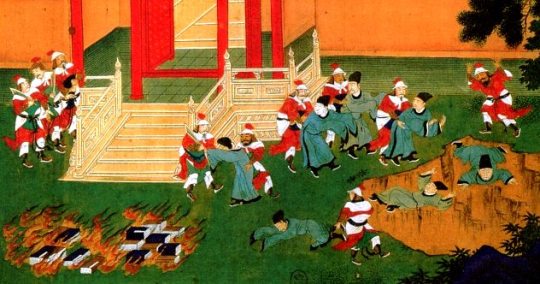
“Tradition had it that after being deceived by two alchemists while seeking prolonged life, Qin Shi Huang ordered more than 460 scholars in the capital to be buried alive in the second year of the proscription. The belief was based on this passage in the Shiji...An account given by Wei Hong in the 2nd century added another 700 to the figure.”

“[T]he reason Han dynasty scholars charged the Qin with destroying the Confucian Five Classics was partly to "slander" the state they defeated and partly because Han scholars misunderstood the nature of the texts, for it was only after the founding of the Han that Sima Qian labeled the Five Classics as "Confucian"...Sima Qian's account of the execution of the scholars has similar difficulties. First, no text earlier than the Shiji mentions the executions...The earliest known use of the famous phrase "burning the books and executing the Confucians" is not noted until the early 4th century.”
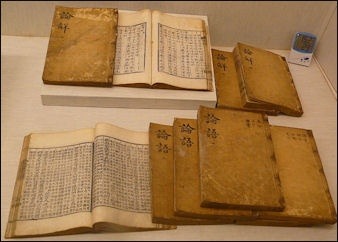
Han dynasty invented printed paper books
Art of the Han
“The art of the Han dynasty (206 BCE - 220 CE) of ancient China is characterised by a new desire to represent everyday life and the stories from history and mythology familiar to all...Han artists pushed forward the boundaries of what was possible to make technically and what was desired aesthetically by the ever-increasing number of art connoisseurs...The art historian Mary Tregear gives the following summary of how art evolved under the Han:
“Whereas in previous ages art had been associated with rituals and ceremonies, gradually evolving into a decorative expression of social status, the art first of the Qin and then of the Han is concerned with myths and everyday life. It was from the outset both a narrative and an expressive art.”

“The Han, like the brief Qin dynasty before them, had acquired a vast swathe of Asia which encompassed many varied cultures, belief systems, and myths. Han rulers realised that art could be a useful tool in collecting this heritage together and presenting a unified and comprehensibly “Chinese” view of the world...Decorative motifs abounded and became highly stylised in border decorations whose uniformity suggests the use of pattern books in the larger urban workshops. These motifs are especially prominent on pottery, lacquerware, and bronze mirrors.”
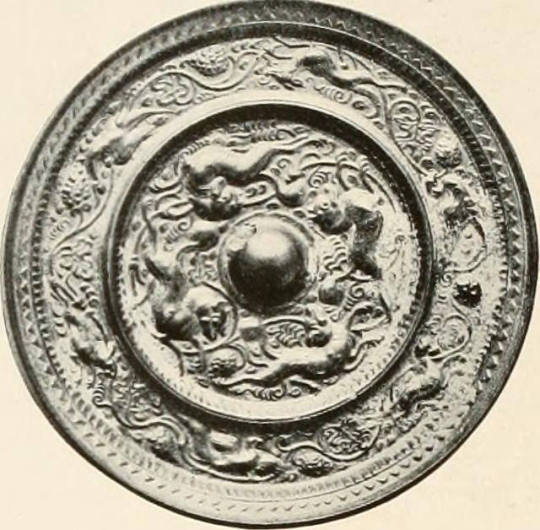
“Wealthy individuals became both patrons and consumers of fine artworks. This demand led to innovations and experimentation in art...As with Chinese painting in general, the aim of the artist was not to copy exactly reality but always to represent the essence of a subject... Bricks were stamped and carved, as was stone...This was a new departure for Chinese art, creating permanent artworks in durable materials...Large figure sculptures are rare from the Han period, but there are some statues representing generals and officials which were stood outside their tombs.”

”Developments in techniques and kilns led to both higher firing temperatures and the first glazed pottery during the Han period. Pottery, especially the vessels painted with a grey slip commonly found in Han tombs, very often imitated the shape and decoration of bronze vessels. Low circular jars with lids and tall vases with a bulbous body and narrow base are characteristic...Clay was also used to produce small unglazed models of ordinary houses...The two-storey models are useful indicators of now lost mud and wood structures; many are complete with adjacent animal pen and figurines of their occupants and animals.”

Xi’an Art Ceramics & Lacquer Factory
“[T]his is a state-run factory that’s been in operation since 1958. It reproduces terra-cotta warriors in sizes ranging from 4 inches to life-size...they are painted in colors resembling the original warriors. Later, when we go to see the actual Terra Cotta Warriors, we’ll find that their colors are no longer evident due to the passage of time and the exposure of the warriors to the atmosphere.”
(via Xi’an Art Ceramics & Lacquer Factory | Catbird In China blog)

#terracottawarriors#hanchineserewritehistory#hancivilofficialsinventedeverything#redpyramids#kiln#mercurydistillation#mercurygoldamalgamation#ancientsecretmercurygold#hanthoughtmercuryprolongedlife#secretqinmercurygoldproduction#sinicization#eastwestculturalexchange#silkroad#gijajoseonmetalproduction#pyramidsofchina#pyramidsofmexico#pyramidsofegypt#gizaplateau#kheopspyramid
1 note
·
View note
Text
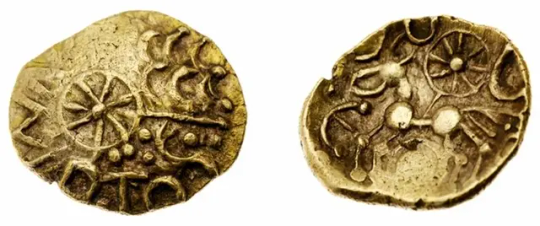
Gold Coin Reveals Unknown British King
New light has been shed on a little-known part of British history thanks to the extraordinary discovery of a coin bearing the name of a forgotten Iron Age ruler in Hampshire, south-east England.
The coin, which has the inscription “Esunertos,” was discovered by a metal detectorist in a field in Hampshire. Esunertos may have ruled as a king from the powerful Danebury Fort, according to experts’ speculation, and this find has been hailed as “one of the outstanding discoveries of recent decades.”
Leading Iron Age experts have studied the coin and deduced it to be struck by a pre-eminent male figure dubbed ‘IISVNIRTOS’ whose name translates as ‘Mighty as the God Esos’.
The coin was struck sometime between 50 and 30 BC, shortly after Julius Caesar’s first Roman raid of Britain in 55 BC.
The coin, which is thought to have been produced between 50 and 30 BC, was struck in conjunction with Julius Caesar’s first Roman raid on Britain in 55 BC when the Roman general and his 20,000 soldiers landed on the Kent coast. Despite a confrontation with Celtic warriors on the beach, the Romans encountered difficulties landing due to rough seas and eventually had to return home.
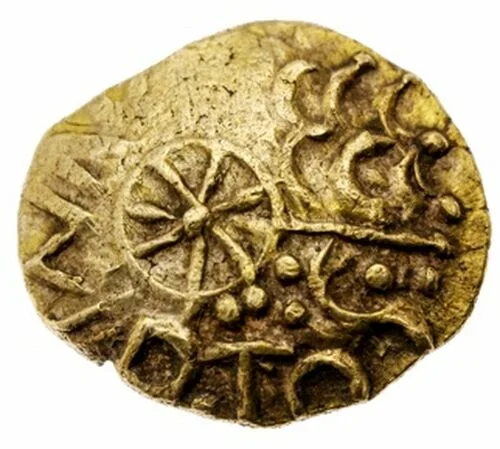
Gregory Edmund, Iron Age Coin Specialist at Spink Auctioneers said: “This fabulous piece of prehistoric artwork completes the mental image we have when we think of Iron Age Britain – the war horse and chariot.
“But it also surprises us with the appearance of classical languages like Latin.
Dr John Sills of the Celtic Coin Index at the Ashmolean Museum said: ‘It is one of the outstanding discoveries of recent decades in Celtic numismatics.’
Initially, it was anticipated that the gold coin would sell for around £4,000 ($5000) at auction. But contrary to all expectations, it broke a record at Spinks Auction by selling for an astounding £20,400 ($25,500).
The coin was found by Lewis Fudge, a metal detectorist who received permission to search a farmer’s field in March this year. Lewis Fudge expressed his elation, stating:
“I am over the moon. If it were not for people in the auction room, I would have jumped around. The collectors I spoke to are gobsmacked. I’m so glad I did not take them up on their private offers before the auction. To think my find has generated its own Wikipedia page is incredible.”
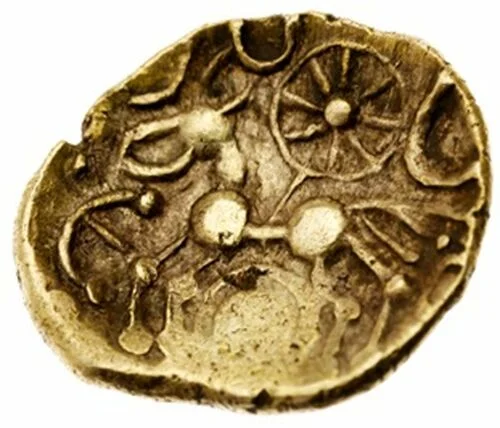
Spink Auctions describe the coin as a quarter slater with the obverse side of the coin bearing the name Esunertos in Latin, and with the worn head of Apollo formed of three interlocking rows of outward facing crescents, a seven-spoked wheel at center in lieu of the ear, and an eye of visage with radiating spike towards the neckline.
The reverse of the coin has a tripled-tailed horse, with a pincer-like mandible for face and linear ear, with pelleted mane, yoke or bucranium above the head, an 8-spoked wheel above spearing into the horse’s back, and double or triple ringed annulet below.
By Leman Altuntaş.

#Gold Coin Reveals Unknown British King#Hampshire England#Danebury Fort#Esunertos#gold#gold coin#ancient gold coin#ancient artifacts#archeology#archeolgst#metal detecting#history#history news#ancient history#ancient culture#ancient civilizations#iron age#celtic history
41 notes
·
View notes